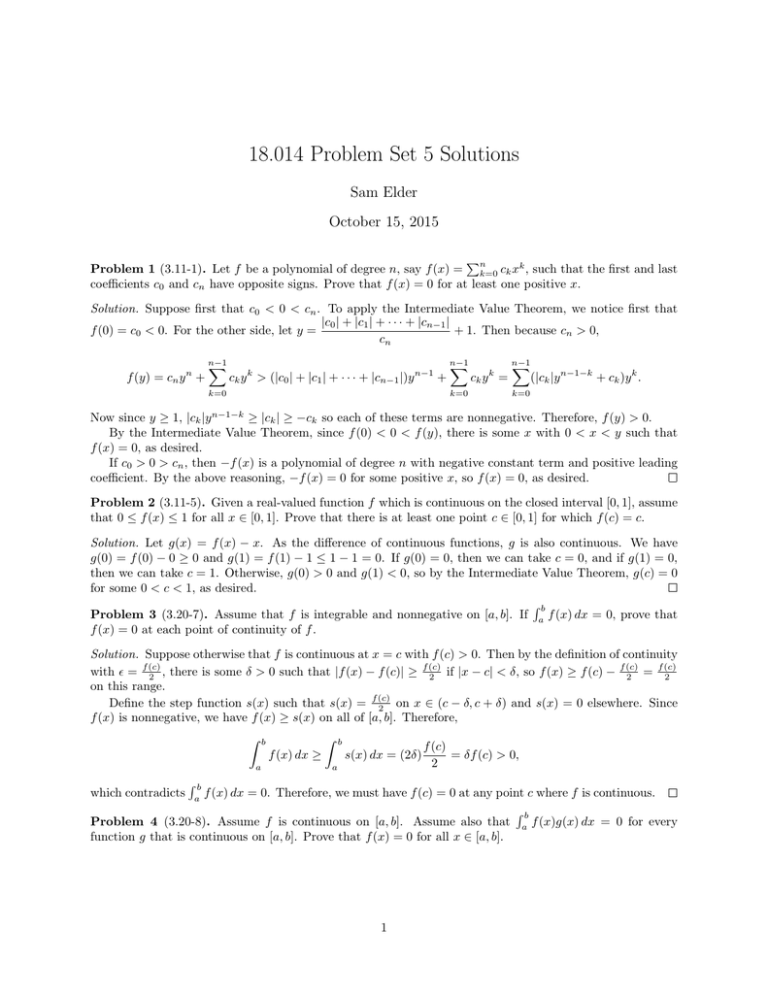18.014 Problem Set 5 Solutions Sam Elder October 15, 2015
advertisement

18.014 Problem Set 5 Solutions
Sam Elder
October 15, 2015
Pn
Problem 1 (3.11-1). Let f be a polynomial of degree n, say f (x) = k=0 ck xk , such that the first and last
coefficients c0 and cn have opposite signs. Prove that f (x) = 0 for at least one positive x.
Solution. Suppose first that c0 < 0 < cn . To apply the Intermediate Value Theorem, we notice first that
|c0 | + |c1 | + · · · + |cn−1 |
f (0) = c0 < 0. For the other side, let y =
+ 1. Then because cn > 0,
cn
f (y) = cn y n +
n−1
X
ck y k > (|c0 | + |c1 | + · · · + |cn−1 |)y n−1 +
n−1
X
k=0
k=0
ck y k =
n−1
X
(|ck |y n−1−k + ck )y k .
k=0
Now since y ≥ 1, |ck |y n−1−k ≥ |ck | ≥ −ck so each of these terms are nonnegative. Therefore, f (y) > 0.
By the Intermediate Value Theorem, since f (0) < 0 < f (y), there is some x with 0 < x < y such that
f (x) = 0, as desired.
If c0 > 0 > cn , then −f (x) is a polynomial of degree n with negative constant term and positive leading
coefficient. By the above reasoning, −f (x) = 0 for some positive x, so f (x) = 0, as desired.
Problem 2 (3.11-5). Given a real-valued function f which is continuous on the closed interval [0, 1], assume
that 0 ≤ f (x) ≤ 1 for all x ∈ [0, 1]. Prove that there is at least one point c ∈ [0, 1] for which f (c) = c.
Solution. Let g(x) = f (x) − x. As the difference of continuous functions, g is also continuous. We have
g(0) = f (0) − 0 ≥ 0 and g(1) = f (1) − 1 ≤ 1 − 1 = 0. If g(0) = 0, then we can take c = 0, and if g(1) = 0,
then we can take c = 1. Otherwise, g(0) > 0 and g(1) < 0, so by the Intermediate Value Theorem, g(c) = 0
for some 0 < c < 1, as desired.
Rb
Problem 3 (3.20-7). Assume that f is integrable and nonnegative on [a, b]. If a f (x) dx = 0, prove that
f (x) = 0 at each point of continuity of f .
Solution. Suppose otherwise that f is continuous at x = c with f (c) > 0. Then by the definition of continuity
f (c)
f (c)
f (c)
with = f (c)
2 , there is some δ > 0 such that |f (x) − f (c)| ≥ 2 if |x − c| < δ, so f (x) ≥ f (c) − 2 = 2
on this range.
Define the step function s(x) such that s(x) = f (c)
2 on x ∈ (c − δ, c + δ) and s(x) = 0 elsewhere. Since
f (x) is nonnegative, we have f (x) ≥ s(x) on all of [a, b]. Therefore,
Z
b
Z
f (x) dx ≥
a
which contradicts
b
s(x) dx = (2δ)
a
Rb
f (c)
= δf (c) > 0,
2
f (x) dx = 0. Therefore, we must have f (c) = 0 at any point c where f is continuous.
Rb
Problem 4 (3.20-8). Assume f is continuous on [a, b]. Assume also that a f (x)g(x) dx = 0 for every
function g that is continuous on [a, b]. Prove that f (x) = 0 for all x ∈ [a, b].
a
1
Rb
Solution. Since f is continuous, we can take g = f . Then a f (x)2 dx = 0. The function h(x) = f (x)2
is continuous as the product of continuous functions, so it is integrable. It is also nonnegative, so by the
previous problem, h(x) = 0 for all x ∈ [a, b] where it is continuous. Since it is continuous on [a, b], h(x) = 0
for all x ∈ [a, b]. Therefore, f (x) = 0 for all x ∈ [a, b], as desired.
Problem 5. Assume f : [0, 1] → R is a continuous function satisfying f (0) = f (1).
Part 5.1. Prove that there is a unique continuous function F : R → R that extends f (i.e. F (x) = f (x) for
x ∈ [0, 1]) and satisfies F (x + 1) = F (x) for all x ∈ R.
Solution. First we show that there is a periodic extension: F (x) = f (x − bxc). For x ∈ [0, 1), bxc = 0 so
F (x) = f (x − 0) = f (x), and for x = 1, F (1) = f (1 − b1c) = f (1 − 1) = f (0) = f (1), so indeed, F extends f .
Moreover, since bx+1c = bxc+1, F (x+1) = f ((x+1)−bx+1c) = f ((x+1)−(bxc+1)) = f (x−bxc) = F (x),
as desired. We must show the following lemma:
Lemma. F (x) = f (x − bxc) is continuous on R.
Proof 1. We break this up into two cases. First, we show it is continuous at x 6∈ Z. Let > 0. Since f is
continuous at w = x − bxc, there is some δ 0 > 0 such that if |y − w| < δ 0 , |f (y) − f (w)| < .
Let δ = min{w, 1 − w, δ 0 } > 0 because x is not an integer, so 0 < w < 1. Then if |z − x| < δ,
z ≥ x − (x − bxc) = bxc and z < x + (1 − (x − bxc)) = bxc + 1, so bzc = bxc. Let y = z − bzc = z − bxc.
Then |z − x| < δ implies |y − w| < δ 0 , so |f (y) − f (w)| < . But F (x) = f (x − bxc) = f (w) and
F (z) = f (z − bzc) = f (y), so |F (z) − F (x)| < , as desired.
Next, we show that F is continuous at x ∈ Z. If x ∈ Z, F (x) = f (x − x) = f (0) = f (1). Let > 0. Since
f is continuous at 0, there is some δ1 > 0 such that if |y − 0| < δ1 , |f (y) − f (0)| < . Since f is continuous
at 1, there is some δ2 > 0 such that if |y − 1| < δ2 , |f (y) − f (1)| < .
Take δ = min{δ1 , δ2 , 1}, and suppose |y −x| < δ. First, if y < x, then y > x−1, so byc = x−1. Therefore,
F (y) = f (y − byc) = f (y − x + 1). Since |y − x| < δ ≤ δ2 , |F (y) − F (x)| = |f (y − x + 1) − f (1)| < , as
desired.
On the other hand, if y > x, then y < x + 1, so byc = x. Therefore, F (y) = f (y − byc) = f (y − x). Since
|y − x| < δ ≤ δ1 , |F (y) − F (x)| = |f (y − x) − f (0)| < , as desired.
Proof 2. We take advantage of the periodicity. First, we show that F (x) is continuous on [0, 1), and then
show that periodicity implies it is continuous everywhere.
To show F (x) is continuous at x = 0, let > 0. Since f is continuous at 0, there is some δ1 > 0 such that
0 < x < δ1 implies |f (x) − f (0)| < . Since f is continuous at 1, there is some δ2 > 0 such that 1 − δ2 < x < 1
implies |f (x) − f (1)| < .
Take δ = min{δ1 , δ2 } > 0 and suppose |x| < δ and x 6= 0. If x > 0, then 0 < x < δ ≤ δ1 , so as
F (x) = f (x) and F (0) = f (0), |F (x) − F (0)| = |f (x) − f (0)| < . If x < 0, then F (x) = F (x + 1) = f (x + 1),
F (0) = f (0) = f (1), and 1 − δ2 ≤ 1 − δ < x + 1 < 1, so |F (x) − F (0)| = |f (x + 1) − f (1)| < .
Now we show that F (x) is continuous at c ∈ (0, 1). Since f is continuous at x, there is some δ 0 > 0
such that |x − c| < δ implies |f (x) − f (c)| < . If we take δ = min{δ 0 , c, 1 − c} > 0 and |x − c| < δ,
x − c > −c so x > 0 and x − c < 1 − c so x < 1. Therefore, F (x) = f (x) and since |x − c| < δ ≤ δ 0 , we have
|F (x) − F (c)| = |f (x) − f (c)| < as desired.
Finally, we use the periodicity to extend this to any c ∈ R. Since 0 ≤ c − bcc < 1, F is continuous at
c − bcc, so there is some δ > 0 such that if |y − (c − bcc)| < δ, |F (y) − F (c − bcc)| < . Now if |x − c| < δ,
|(x − bcc) − (c − bcc)| < δ, so |F (x − bcc) − F (c − bcc)| < . But F (x) = F (x − bcc) and F (c) = F (c − bcc)
by repeated application of periodicity, so |F (x) − F (c)| < , as desired.
We are also asked to show the following lemma:
Lemma. Any function F satisfying these properties is unique.
2
Proof 1. Suppose that F (x) and G(x) both satisfy these two properties. Since both extend f , we have
F (x) = G(x) for all x ∈ [0, 1]. First suppose that F (x) 6= G(x) for some x > 1.
Consider the set of places where they differ: S = {x : F (x) 6= G(x), x > 1}. Since this set is bounded
below and nonempty (by assumption), it has a infimum y, so F (x) = G(x) for 0 ≤ x < y. By Theorem
I.32(b), there exists some z ∈ S with z < y + 1. Then z − 1 < y and z − 1 ≥ y − 1 > 0 so F (z − 1) = G(z − 1).
But applying the periodicity assumption, F (z) = F (z − 1) = G(z − 1) = G(z), a contradiction. So S must
be empty, i.e. F (x) = G(x) for all x > 1.
Similarly, suppose that F (x) 6= G(x) for some x < 0, and let S = {x : F (x) 6= G(x), x < 0}. This set
is bounded above and nonempty, so it has a supremum y, and F (x) = G(x) for y < x ≤ 1. By Theorem
I.32(a), there exists some z ∈ S with z > y − 1. Then z + 1 > y and z + 1 ≤ y + 1 ≤ 1, so F (z + 1) = G(z + 1).
But applying the periodicity assumption, F (z) = F (z + 1) = G(z + 1) = G(z), a contradiction. So S must
be empty, i.e. F (x) = G(x) for all x < 0 as well, and hence for all x. We are done showing uniqueness.
Proof 2. First we claim that F (x + n) = F (x) for any positive integer n, by induction.
Base Case. When n = 1, indeed, F (x + 1) = F (x) is the given property.
Inductive Step. If F (x + n) = F (x), then applying periodicity, F (x + n + 1) = F (x + n) = F (x), completing
the induction step.
Now substituting x − n for x, we have F (x − n) = F (x), so F (x + n) = F (x) for any integer n. Therefore,
for any x ∈ R, F (x) = F (x − bxc). But bxc ≤ x < bxc + 1, so x − bxc ∈ [0, 1), and F (x − bxc) = f (x − bxc).
Therefore, F (x) = f (x − bxc) is the unique function satisfying these properties.
Having shown that such a function exists and is unique, we are done.
Part 5.2. Let F be the function constructed in part (a). Prove that for any c ∈ R, there exists p ∈ R such
that F (p + c) = F (p).
Solution. Define the function g(x) = F (x + c) − F (x) for x ∈ [0, 1]. As a difference of continuous functions,
g is continuous, hence integrable. Now we examine g more closely. For 0 ≤ x < 1 − (c + bcc), bcc ≤ c ≤
x + c < bcc + 1, so F (x + c) = f (x + c − bcc). Since F (x) = f (x), we have g(x) = f (x + c − bcc) − f (x) on
this interval.
For 1 − (c − bcc) ≤ x ≤ 1, we have bcc + 1 ≤ x + c < x + bcc + 1 ≤ bcc + 2, so F (x + c) = f (x + c − bcc − 1).
Since F (x) = f (x), we have g(x) = f (x + c − bcc − 1) − f (x) on this interval.
Now we split up the integral of g on [0, 1] and shift the components around:
Z
1
Z
1−(c−bcc)
g(x) dx =
0
Z
1
g(x) dx +
0
Z
g(x) dx
1−(c−bcc)
1−(c−bcc)
Z
1
(f (x + c − bcc) − f (x)) dx +
=
0
Z
1−(c−bcc)
Z
1
Z
f (x + c − bcc) dx +
=
0
Z
(f (x + c − bcc − 1) − f (x)) dx
1−(c−bcc)
f (x + c − bcc − 1) dx −
1−(c−bcc)
1
=
Z
c−bcc
c−bcc
Z
f (x) dx −
f (x) dx +
0
1
f (x) dx
0
1
f (x) dx = 0.
0
Therefore, by the Mean Value Theorem for integrals (Theorem 3.15), there is some p ∈ [0, 1] such that
R1
g(p)(1 − 0) = 0 g(x) dx = 0, i.e. g(p) = 0 and F (p + c) = F (p), as desired.
Problem 6.
Part 6.1. Let f, g : [a, b] → R be continuous functions satisfying f (x) > g(x) for all x ∈ [a, b]. Prove that
there exists a positive real number C > 0 such that the inequality can be strengthened to f (x) > g(x) + C
for all x ∈ [a, b].
3
Solution. The function h(x) = f (x) − g(x) is continuous as the difference of continuous functions. Since h is
defined on an interval [a, b], by the Extreme Value Theorem (Theorem 3.12), h has a minimum value v that
it attains: h(x) ≥ v for all x, and h(x) = v for some x ∈ [a, b]. Since h(x) > 0 for all x, we must have v > 0,
and take C = v2 . Then h(x) ≥ v > C for all x ∈ [a, b], so f (x) > g(x) + C for all x ∈ [a, b], as desired.
Part 6.2. Give a counterexample to the previous part if f and g are not required to be continuous.
Solution. Define g(x) = 0 and
(
f (x) =
0<x≤1
x = 0,
x
1
both on the interval [0, 1]. Then f (x) = x > 0 = g(x) for all x > 0, and f (0) = 1 > 0 = g(0), so this satisfies
the hypothesis. Suppose there is some C > 0 such that f (x) > g(x) + C for all x ∈ [0, 1]. Taking x = 1,
C < 1, so taking x = C, f (C) = C > 0 + C, a contradiction. So no such C exists.
Of course, this violates the previous cases, because f is not continuous at 0.
4







